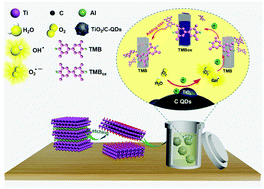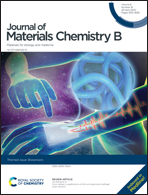Ti3C2Tx MXene-derived TiO2/C-QDs as oxidase mimics for the efficient diagnosis of glutathione in human serum†
Abstract
Nanozyme-based colorimetry was suggested to be a rapid method for biomarker (e.g. glutathione) detection, but this method suffers from lack of efficiency and low-toxicity nanozymes till now. Herein, quantum dots of TiO2 loaded on carbon (TiO2/C-QDs) oxidase-like nanozymes were prepared via a hydrothermal treatment of tiny and few-layered Ti3C2Tx MXene nanosheets, which possess abundant thermodynamic metastable Ti atoms on MXene margins as raw materials for the preparation of TiO2/C-QDs. The oxygen vacancy in TiO2 on the surface of the carbon matrix can facilitate O2 adsorption in the solution and generate reactive oxygen species (ROS), thereby quickly oxidizing 3,3′,5,5′-tetramethylbenzidine (TMB) to its oxidized form (TMBox) in the absence of H2O2. After adding glutathione (GSH), TMBox was able to be restored to TMB, which resulted in a corresponding decrease in the UV-vis absorbance value at 652 nm. Furthermore, this assay possesses good selectivity, excellent specificity and high sensitivity (limit of detection: 0.2 μM), which made it possible to efficiently detect GSH in complex biological samples such as human serum.

- This article is part of the themed collection: Biosensors


 Please wait while we load your content...
Please wait while we load your content...